In this article, readers will discover a wealth of information about the common backyard birds of Indiana. Compiled from data collected through the citizen science program eBird, this comprehensive guide offers a close-up look at the bird species you are likely to encounter in your own backyard. From the vibrant Northern Cardinal, which takes the top spot as the most common bird in Indiana, to lesser-known species, each bird is showcased with pictures and helpful identification tips. And for those looking to attract these feathery friends, the article also shares valuable insights on how to create a backyard haven for birds. Whether you’re a seasoned birder or a newcomer to the world of birdwatching, this article provides a valuable resource for identifying and appreciating the avian wonders of Indiana.
Northern Cardinal
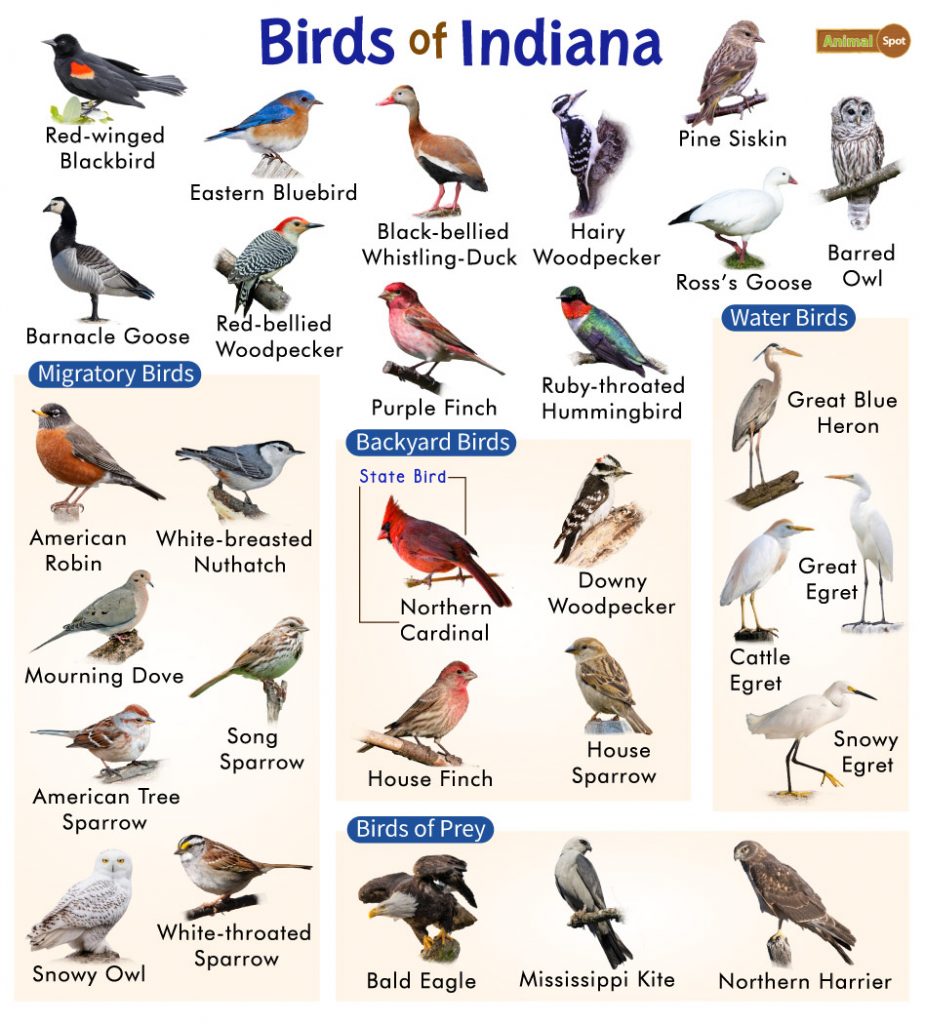
Overview
The Northern Cardinal, scientifically known as Cardinalis cardinalis, is one of the most common and beloved backyard birds in Indiana. With its striking red plumage and distinctive crest, the Northern Cardinal is easily recognizable and a delight to observe. This article provides an overview of the Northern Cardinal, including identification tips, habitat and range information, as well as tips on how to attract this beautiful bird to your backyard.
Identification
The Northern Cardinal is a medium-sized songbird, with an average length of about 8-9 inches. The male Cardinal is easily identified by its vibrant red plumage, black mask on its face, and a prominent crest on the top of its head. In contrast, the female Cardinal has a more subdued coloration, with a reddish-brown body and a touch of red on its crest and wings. Both male and female Cardinals have sturdy, cone-shaped bills, perfect for cracking open seeds.
Habitat and Range
The Northern Cardinal can be found throughout the eastern and central regions of the United States, including Indiana. Its preferred habitat includes woodlands, suburban areas, and gardens with plenty of dense shrubs and trees. Cardinals are non-migratory birds, meaning they stay in their territories year-round. They are adaptable and can thrive in a variety of habitats, making them a common sight in residential areas.
Attracting to Your Backyard
To attract Northern Cardinals to your backyard, it is important to provide them with the right combination of food, water, and shelter. Cardinals are primarily seed-eaters, so offering a variety of seeds, such as sunflower seeds and safflower seeds, in bird feeders can entice them to visit. They also enjoy fruits like berries and apples. Adding dense shrubs and trees to your yard can provide them with nesting sites and shelter. Cardinals are known to be attracted to the sound of running water, so consider adding a small birdbath or a water fountain to your yard.
Pictures


American Robin
Overview
The American Robin, scientifically known as Turdus migratorius, is a familiar and easily identifiable bird in Indiana. With its reddish-orange breast and gray-brown back, the American Robin is a common sight in parks, backyards, and woodland areas throughout the state. This article provides an overview of the American Robin, including identification tips, habitat and range information, as well as tips on how to attract this delightful bird to your backyard.
Identification
The American Robin is a medium-sized thrush, measuring about 10-11 inches in length. It has a plump body, with a distinctive reddish-orange breast that contrasts with its gray-brown back. The Robin also has a white belly, a blackish head, and a yellow bill. The males and females of this species look similar, making identification relatively easy.
Habitat and Range
American Robins can be found throughout the United States, including Indiana. They are highly adaptable birds that can be seen in a variety of habitats, including woodlands, parks, suburban areas, and even city streets. Robins prefer areas with open spaces, but they also rely on trees and shrubs for nesting and foraging. In the winter, some Robins may migrate to warmer regions, while others may stay year-round in milder climates.
Attracting to Your Backyard
To attract American Robins to your backyard, it is important to provide them with a diverse range of food sources. Robins are omnivorous, feeding on a variety of foods, including earthworms, insects, berries, and fruits. Adding a birdbath with a shallow basin can also attract Robins, as they enjoy bathing and drinking water. Providing nesting platforms or leaving piles of leaf litter can encourage them to build nests in your yard.
Pictures


Eastern Bluebird
Overview
The Eastern Bluebird, scientifically known as Sialia sialis, is a small and charming bird that can be found in open grasslands and woodlands of Indiana. With its vibrant blue plumage and rusty-red breast, the Eastern Bluebird is a delight to observe. This article provides an overview of the Eastern Bluebird, including identification tips, habitat and range information, as well as tips on how to attract this beautiful bird to your backyard.
Identification
The Eastern Bluebird is a small thrush, measuring about 6-7 inches in length. The male Eastern Bluebird has a bright blue back and wings, with a rusty-red breast and throat. The female has similar coloring, but with a more subdued appearance. Both sexes have a white belly and a thin bill. Eastern Bluebirds are often seen perched on fences, wires, and tree branches, searching for insects or small berries.
Habitat and Range
Eastern Bluebirds can be found throughout the eastern and central regions of the United States, including Indiana. They prefer open spaces with scattered trees, such as meadows, pastures, and golf courses. Eastern Bluebirds rely on tree cavities for nesting, and they are known to use artificial nest boxes placed by humans. They are non-migratory birds, but some individuals may move to lower elevations or more southern regions during the winter.
Attracting to Your Backyard
To attract Eastern Bluebirds to your backyard, it is important to provide them with suitable nesting sites and a diverse range of food sources. Installing specially designed nest boxes with appropriate dimensions can help provide them with a safe place to raise their young. Eastern Bluebirds primarily feed on insects, so keeping your yard free of pesticides can create a healthy environment for them. Adding fruit-bearing plants, such as dogwood or serviceberry, can also attract them by providing a natural food source.
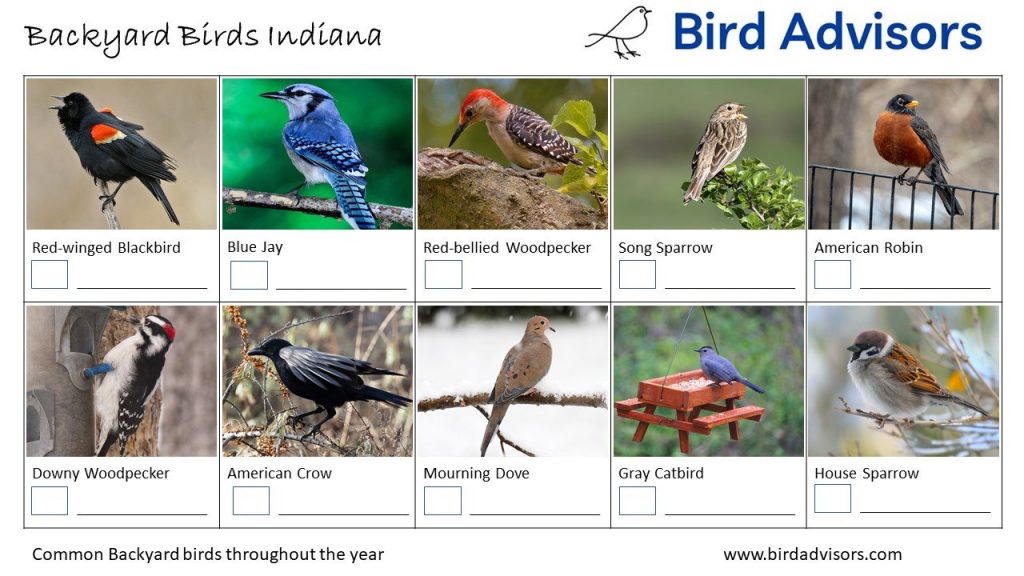
Pictures


Mourning Dove
Overview
The Mourning Dove, scientifically known as Zenaida macroura, is a gentle and graceful bird that can often be seen in Indiana. With its soft, mournful cooing and streamlined body, the Mourning Dove is a common visitor to backyards and open fields. This article provides an overview of the Mourning Dove, including identification tips, habitat and range information, as well as tips on how to attract this peaceful bird to your backyard.
Identification
The Mourning Dove is a medium-sized bird, measuring about 9-13 inches in length. It has a slender body and a long, pointed tail. The plumage of the Mourning Dove is primarily gray-brown, with a lighter underside. It has a small, round head, with dark eyes and a black bill. Mourning Doves often appear to have a pale, bluish hue when seen in sunlight.
Habitat and Range
Mourning Doves can be found throughout North America, including Indiana. They are adaptable birds, and they can be seen in a variety of habitats, including woodlands, open fields, and suburban areas. Mourning Doves prefer areas with scattered trees or sheltered perches, where they can rest and observe their surroundings. They are also known to use human-made structures, such as power lines and fences, as perches.
Attracting to Your Backyard
To attract Mourning Doves to your backyard, it is important to provide them with food sources and a peaceful environment. Mourning Doves primarily feed on seeds, so offering a variety of seeds in bird feeders can entice them to visit. Sunflower seeds, cracked corn, and millet are all popular choices. Providing a platform feeder or a ground feeder can also accommodate their feeding habits. Mourning Doves prefer open spaces, so keeping your yard free of dense vegetation can create an inviting space for them.
Pictures


Blue Jay
Overview
The Blue Jay, scientifically known as Cyanocitta cristata, is a striking and vocal bird that is commonly seen in Indiana. With its vibrant blue feathers, black crest, and white markings, the Blue Jay is a favorite among birdwatchers. This article provides an overview of the Blue Jay, including identification tips, habitat and range information, as well as tips on how to attract this charismatic bird to your backyard.
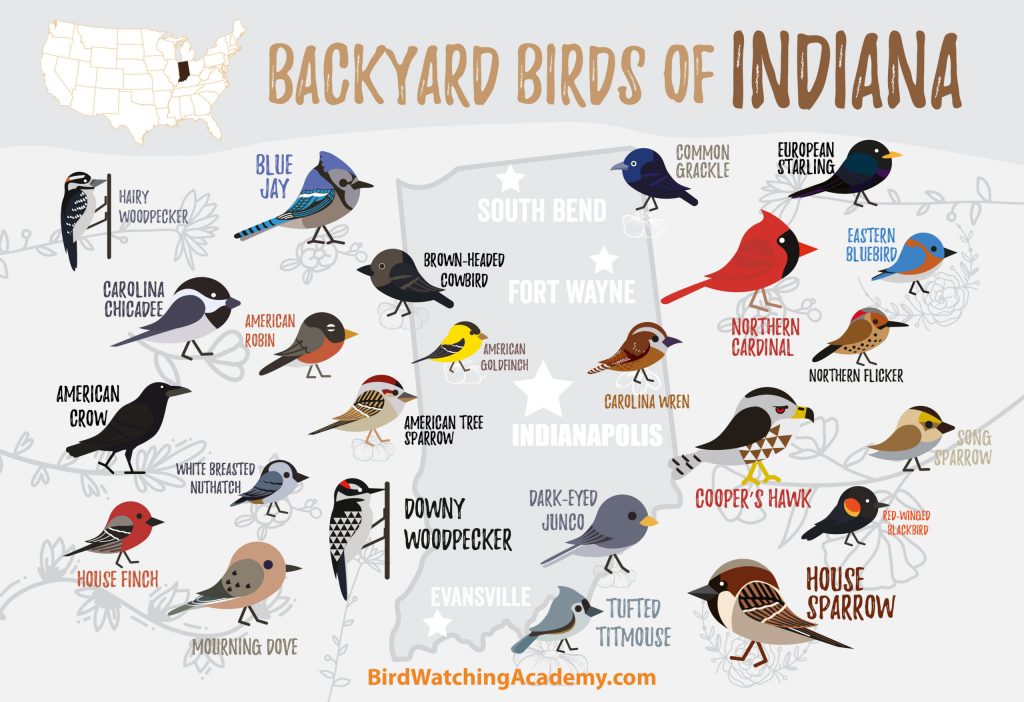
Identification
The Blue Jay is a medium-sized bird, measuring about 9-12 inches in length. It has a stout body, with a prominent crest on its head. The plumage of the Blue Jay is predominantly blue, with white markings on its wings and tail. It has a black collar around its neck, a black bill, and a black facial mask that extends from its beak to its eyes. Blue Jays are known for their loud and varied vocalizations.
Habitat and Range
Blue Jays can be found throughout the eastern and central regions of the United States, including Indiana. They are highly adaptable birds that can be seen in a variety of habitats, including woodlands, parks, and residential areas. Blue Jays prefer areas with mature trees, where they can find both food and shelter. They are also known to visit bird feeders, especially when offered peanuts, sunflower seeds, or suet.
Attracting to Your Backyard
To attract Blue Jays to your backyard, it is important to provide them with a variety of food sources. Blue Jays are omnivorous, feeding on a wide range of foods, including insects, fruits, nuts, and seeds. Offering peanuts or sunflower seeds in bird feeders can entice them to visit. Blue Jays also appreciate water sources, so providing a birdbath with a shallow basin can attract them. Adding trees and shrubs to your yard can create a suitable habitat and nesting sites for them.
Pictures


House Sparrow
Overview
The House Sparrow, scientifically known as Passer domesticus, is a small and familiar bird that can be found in urban and suburban areas of Indiana. With its brownish-gray plumage and black bib on its throat, the House Sparrow is a common sight around human habitations. This article provides an overview of the House Sparrow, including identification tips, habitat and range information, as well as tips on how to attract this adaptable bird to your backyard.
Identification
The House Sparrow is a small songbird, measuring about 5.5-6 inches in length. It has a stocky body and a thick bill. The males of this species have a distinctive appearance, with a gray crown, a black bib on their throat, and a chestnut-colored back. The females and young House Sparrows have a more subdued coloring, with brownish-gray feathers and a pale throat. House Sparrows are known for their energetic chirping.
Habitat and Range
House Sparrows are native to Europe and Asia, but they have become widespread in North America, including Indiana, since their introduction in the mid-1800s. They are highly adaptable birds that can be found in a variety of habitats, including cities, towns, gardens, and farmland. House Sparrows thrive in areas with human habitation, as they rely on human-made structures, such as buildings and nest boxes, for nesting sites.
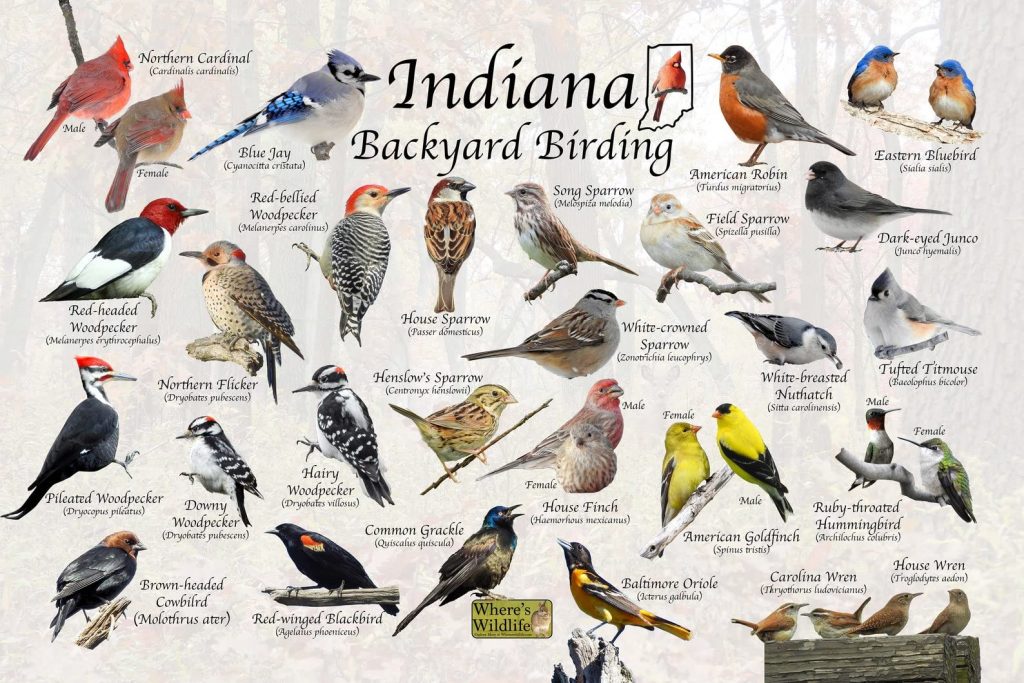
Attracting to Your Backyard
Attracting House Sparrows to your backyard is relatively easy, as they are highly adaptable and have a broad diet. House Sparrows primarily feed on seeds, grains, and insects, so offering a variety of seeds in bird feeders can attract them. They also appreciate access to water, so providing a birdbath or a shallow water source can entice them. House Sparrows are social birds, so they are more likely to visit feeders in groups.
Pictures


Tufted Titmouse
Overview
The Tufted Titmouse, scientifically known as Baeolophus bicolor, is a small and lively bird that is commonly seen in woodlands and suburban areas of Indiana. With its gray feathers, distinctive crest, and black markings on its face, the Tufted Titmouse is a favorite among bird enthusiasts. This article provides an overview of the Tufted Titmouse, including identification tips, habitat and range information, as well as tips on how to attract this charming bird to your backyard.
Identification
The Tufted Titmouse is a small songbird, measuring about 6-6.5 inches in length. It has a round body, with a short neck and a prominent crest on its head. The plumage of the Tufted Titmouse is predominantly gray, with a white belly and rust-colored flanks. It has a black forehead, black markings around its eyes, and a black bill. Tufted Titmice are known for their energetic and acrobatic movements.
Habitat and Range
Tufted Titmice can be found throughout the eastern and central regions of the United States, including Indiana. They are birds of deciduous and mixed woodlands, but they are also known to visit suburban areas and backyard feeders. Tufted Titmice prefer areas with mature trees, where they can find both food and nesting sites. They are non-migratory birds, meaning they stay in their territories year-round.
Attracting to Your Backyard
To attract Tufted Titmice to your backyard, it is important to provide them with the right combination of food, water, and shelter. Tufted Titmice are primarily insectivorous, but they also feed on seeds and nuts. Offering a variety of food sources, such as suet, sunflower seeds, and peanuts, in bird feeders can entice them to visit. Providing nesting boxes or natural cavities can also attract them, as they prefer to nest in tree cavities.
Pictures


Red-tailed Hawk
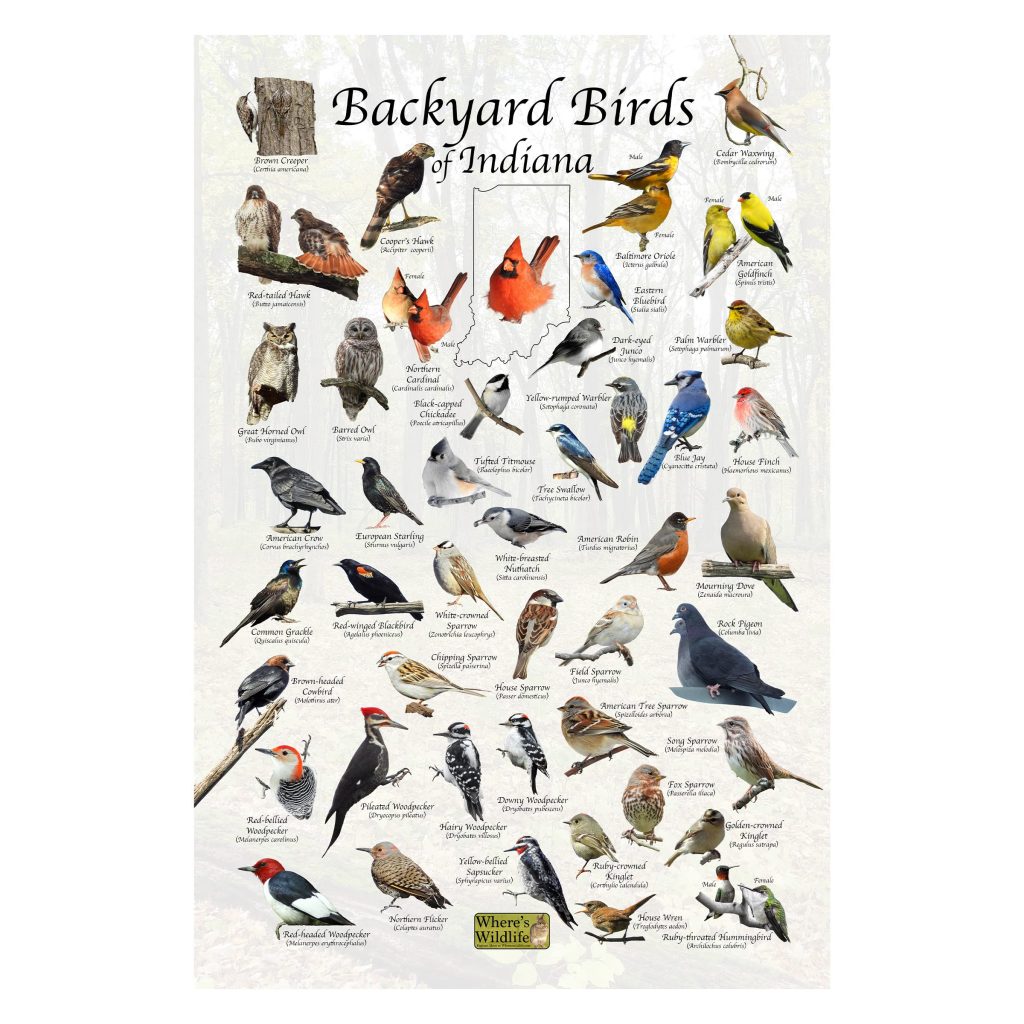
Overview
The Red-tailed Hawk, scientifically known as Buteo jamaicensis, is a majestic bird of prey that can be found in Indiana. With its large size, broad wings, and a distinct red tail, the Red-tailed Hawk is a captivating sight in the sky. This article provides an overview of the Red-tailed Hawk, including identification tips, habitat and range information, as well as tips on how to observe and appreciate this impressive raptor.
Identification
The Red-tailed Hawk is a large raptor, with a wingspan of about 4 feet and a length of about 18-26 inches. It has a robust body, with broad wings and a short, wide tail. The plumage of the Red-tailed Hawk is highly variable, but most adults have a brown back, a pale underside with a dark belly band, and a rusty-red tail. The head of the Red-tailed Hawk is often lighter in color and has a pale throat. Juvenile Red-tailed Hawks have a mottled appearance.
Habitat and Range
Red-tailed Hawks can be found throughout North America, including Indiana. They are adaptable birds that can be seen in a variety of habitats, such as forests, grasslands, and even urban areas. Red-tailed Hawks prefer areas with open spaces, where they can find prey, such as rodents and small birds. They rely on tall trees or human-made structures, such as utility poles or tall buildings, for perching and nesting.
Attracting to Your Backyard
Attracting Red-tailed Hawks to your backyard is not practical, as they are large birds of prey and require vast territories for hunting and nesting. However, you can observe and appreciate these impressive raptors by visiting open areas, such as grasslands or nature reserves, where they are known to soar and hunt. Always observe from a safe distance and avoid disturbing them. Red-tailed Hawks are protected by law, and it is illegal to disturb their nests or harm them.
Pictures


Chipping Sparrow
Overview
The Chipping Sparrow, scientifically known as Spizella passerina, is a small and lively bird that is commonly seen in woodlands and residential areas of Indiana. With its rusty cap, grayish-brown back, and white belly, the Chipping Sparrow is a delightful addition to any backyard birdwatching session. This article provides an overview of the Chipping Sparrow, including identification tips, habitat and range information, as well as tips on how to attract this charming bird to your backyard.
Identification
The Chipping Sparrow is a small songbird, measuring about 4.5-5 inches in length. It has a slim body and a small bill. The plumage of the Chipping Sparrow is predominantly grayish-brown, with a bright rusty cap on its head. It has a white belly and a fine, black bill. During the breeding season, male Chipping Sparrows may sing a distinctive chipping song, from which the bird gets its name.
Habitat and Range
Chipping Sparrows can be found throughout North America, including Indiana. They are birds of open woodlands, shrubby areas, and residential areas with plenty of trees and shrubs. Chipping Sparrows typically breed in northern regions and migrate to warmer regions, such as Indiana, during the winter. They are highly adaptable birds and can be seen in a variety of habitats, including parks, gardens, and even cemeteries.
Attracting to Your Backyard
To attract Chipping Sparrows to your backyard, it is important to provide them with the right combination of food, water, and shelter. Chipping Sparrows primarily feed on seeds, especially those of grasses and weeds. Offering a variety of seeds in bird feeders, such as millet and sunflower seeds, can entice them to visit. Providing shrubs and dense vegetation in your yard can provide them with nesting sites and shelter.
Pictures


Common Bird Species by Season
Spring
Spring is a season of renewal and change, and it is a time when many bird species return to Indiana after wintering in warmer regions. Some common bird species that can be seen in Indiana during the spring months include:
-
Warblers: During the spring, various species of warblers pass through Indiana during their migration. These small, colorful birds are known for their vibrant plumage and melodious songs. Common warbler species include the Yellow Warbler, Black-throated Green Warbler, and the Magnolia Warbler.
-
Orioles: Orioles are brightly colored birds that are known for their beautiful songs and elaborate nests. The Baltimore Oriole and the Orchard Oriole are two common species that can be seen in Indiana during the spring. These birds are attracted to nectar feeders and fruit trees.
-
Hummingbirds: Hummingbirds are tiny birds with iridescent feathers and the ability to hover in mid-air. The Ruby-throated Hummingbird is the only species of hummingbird that nests in Indiana. Providing nectar feeders filled with a sugar-water solution can attract these delightful birds to your backyard.
Summer
Summer is a vibrant and active season for birdwatching in Indiana. The warm weather brings out a variety of bird species, including:
-
Swallows: Swallows are graceful aerial acrobats that can be seen darting through the air, catching insects on the wing. The Tree Swallow and the Barn Swallow are two common species that can be found in Indiana during the summer months. They often nest in cavities or under eaves.
-
Sparrows: Sparrows are small, energetic birds that are known for their melodic songs. The Song Sparrow and the Field Sparrow are two common species that can be seen in Indiana during the summer. They prefer grassy areas with shrubs and are often found near water sources.
-
Woodpeckers: Woodpeckers are unique birds with specialized adaptations for drumming and excavating holes in trees. The Downy Woodpecker and the Red-bellied Woodpecker are two common species that can be found in Indiana during the summer. Providing suet feeders can attract these birds to your yard.
Fall
Fall is a season of change and transition, as many bird species begin their southward migration. Some common bird species that can be seen in Indiana during the fall months include:
-
Sandhill Cranes: Sandhill Cranes are large, elegant birds that pass through Indiana during their migration. These birds are known for their distinctive call and their graceful flight. They can often be seen in flocks, feeding in fields and marshes.
-
Hawks and Falcons: Fall is a great time to observe raptors as they migrate through Indiana. The Red-tailed Hawk and the American Kestrel are two common species that can be seen during this season. Look for them soaring in the sky or perched on utility poles.
-
Canada Geese: Canada Geese are familiar birds that can be seen in large numbers during their fall migration. These birds fly in “V” formations, honking as they pass overhead. They often stop in wetlands and fields to rest and feed.
Winter
Winter is a challenging time for birds in Indiana, as they face cold temperatures and limited food sources. However, some species are well-adapted to these conditions and can be seen throughout the winter months, including:
-
Dark-eyed Junco: The Dark-eyed Junco is a small songbird with a plump body and a grayish-brown back. These birds are often seen hopping around on the ground, feeding on seeds. They can be found in woodlands, gardens, and suburban areas.
-
American Goldfinch: The American Goldfinch is a small, bright yellow bird that stands out against the winter landscape. These birds feed on thistle and sunflower seeds and are often seen in flocks. Providing nyjer or sunflower seed feeders can attract them to your yard.
-
Northern Cardinal: The Northern Cardinal, the most common bird in Indiana, can be seen year-round, even during the winter months. Their vibrant red plumage stands out against the snow, and they can often be found at bird feeders, feeding on seeds.
In conclusion, Indiana is home to a diverse array of bird species throughout the year. By providing the right combination of food, water, and shelter, as well as creating a welcoming habitat, you can attract a variety of these beautiful birds to your backyard and enjoy their presence all year long.
Leave a Reply